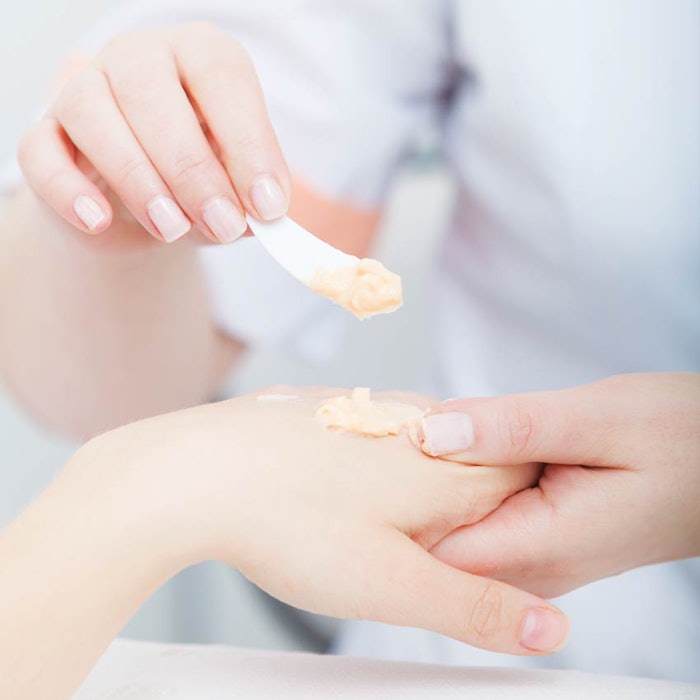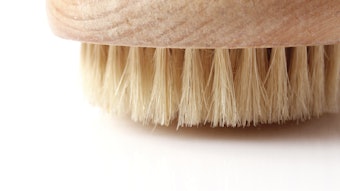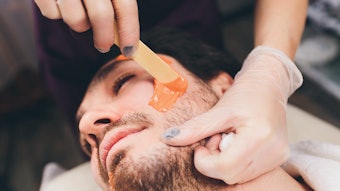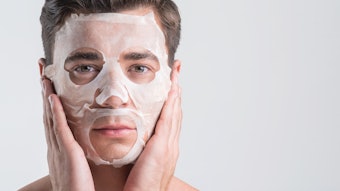
Hand rejuvenation is rapidly becoming a hot topic from coast to coast. With the meteoric growth of social media, engagement ring selfies have widespread mass appeal. The median age at which women get married also has increased by almost five years, making hand rejuvenation for engagement photos the newest cosmetic trend.
The increase in nonsurgical hand rejuvenation procedures affects all estheticians, nail technicians and therapists that perform body work. Spa professionals must be aware of the effects and contraindications of nonsurgical hand rejuvenation procedures and be able to offer options for treatment. The importance of client intake forms cannot be over emphasized. Malpractice suits don’t just happen to laser technicians, all practitioners are liable for the clients in their care.
Clients are spending thousands on results-oriented procedures, and they are frequently not apprised of the duration of post-procedure healing or what treatments they can experience during recovery.
Education first
Education is the most powerful tool in a skin care professional’s arsenal. Having knowledge of cutting-edge technologies, nanotechnologies, and keeping up with genetic and medical advancements, will not only help you fight clients’ battles against skin aging, but also enable you to educate them about how to optimize treatment. However, in order to do that, a skin care professional must have a thorough understanding of skin physiology.
What are telomeres? Genes are positioned along twisted double stranded molecules of DNA inside the nucleus of the cells (chromosomes), which carry genetic information. At the end of the chromosomes is a length of DNA and protein called telomeres, which guard genetic information, stabilize chromosomes and enable cell division.
Every time a cell replicates, some of the telomere is lost. Telomeres hold answers to the mystery of aging and the risk of genetic disease. Telomeres are likened to the cap on the end of a shoelace, for they help keep the ends of the chromosomes from fraying, becoming damaged and destroying genetic information.
When telomeres shorten, it compromises the structural integrity of the cells, hastening cell death. Scientists have made immeasurable strides in genetics since 1961, when pioneer Leonard Hayflick, PhD first theorized that cells had a limited replication process. There are still many unanswered questions regarding telomere length and lifespan. However, what is known is that oxidative stress accelerates telomere loss and stabilized antioxidants decelerate telomere loss. Stabilized antioxidants are to the skin, what a plant-based diet and exercise is to the internal organs.
Many topical skin-lightening botanical extracts such as aloesin, arbutin, licorice root and mulberry are also superoxide scavengers that offer protection and are effective in inhibiting tyrosinase activity—and consequently, melanin formation.
Aging hands
As the body ages, the hands reveal prominent veins, tendons, muscles and bones. Pigmentation changes also occur, including lentigenes, seborrheic keratosis and actinic keratosis. On a daily basis, the skin cells on the hands can be exposed to more than 73,000 damaging assaults, the most prevalent of which is photodamage.
About 90% of visible age-related changes manifest on the hands as wrinkles, brown spots and leathery skin are caused by UV exposure. Actinic keratosis and squamous cell carcinomas are the most common lesions on the hands.
UVA rays (320–400nm) account for approximately 95% of UV radiation that reaches the earth. Recent studies indicate that UVA should no longer be thought of as simply the aging rays. Studies are ongoing, however, it appears as though UVA may initiate and provoke the development of skin cancer. It is present in all daylight, though less intense than UVB, it is 30–50 times more prevalent and can penetrate non-laminated glass and cloud cover. Scientists previously believed that less UVA was absorbed by DNA, causing less dangerous mutations, but new research indicates that UVA rays may cause more genetic damage than UVB to keratinocytes in the basal layer, where most skin cancers begin. UVB (burning rays) are shorter rays (290–320nm) that penetrate the epidermis and are associated with burning, tanning, and skin cancer. These rays are most significant between 10 am and 4 pm, and they can’t penetrate glass.
Sunscreen defense
A good defense is the best offense. Educate clients to cover the hands with a moisturizing sunscreen a half hour before going into the sun, reapplying every two hours or after the skin becomes wet. Don’t forget the nails, because the tissue under the nail is metabolically active and susceptible to melanoma and squamous cell carcinoma.
A broad-spectrum sunscreen of SPF 30 should have a combination of the following UVA-filtering ingredients: ecamsule, oxybenzone, stabilized avobenzone, titanium dioxide and zinc oxide. A moisturizing SPF cream is preferred over a lotion, because the skin needs to have proper water-to-oil balance to create the hydrolipidic film, and a cream will be more occlusive, preventing transepidermal water loss (TEWL). Using a moisturizer with ceramides, silicone, peptides and stabilized antioxidant serum at bedtime will enhance the skins natural self-repair process, which occurs during sleep, and will also prolong the benefits of any treatment.
Treatments and procedures
The best hand rejuvenation treatments and procedures vary per clients, but the following serves as an overview of options to research further.
Alpha hydroxy acids (AHAs). Chemical exfoliants such as glycolic, citric, tartaric, lactic and malic acids will dissolve intercellular glue, revealing smoother skin, fewer spots and a more even tone. Drawbacks include: Misuse can cause sensitization, and sunscreen is crucial while using is a must.
Retinoids. To treat spots, retinoids are a common solution to reduce pigmentation by inhibiting tyrosinase transcription, interrupting melanin synthesis. Drawbacks include: It can cause irritation and peeling for some clients.
Cryosurgery liquid. A dermatologic treatment in which surface skin lesions are frozen, it is likely the best medical treatment for seborrheic keratosis and also can be used to treat actinic keratosis. Drawbacks include: Possible hypo- or hyperpigmentation, and no spa treatments should be performed for three weeks or until healed.
Lasers. Lasers used in medical offices increase collagen regeneration, resurface skin, improve tone, and diminish wrinkles, sun damage and scarring. Newer fractional lasers use an ablative laser beam that is fractured into tiny beams targeting smaller areas. Drawbacks include: Research is time-consuming, but vital. A skillful medical professional must be chosen or clients risk burns or increased pigmentation, and there is downtime. Sunscreen is required to maintain results.
Intense pulsed light (IPL). IPL utilizes non-ablative filtered light wavelengths so the heat is absorbed into the dermal tissue. This is effective on redness and solar lentigenes. Drawbacks include: It can be performed only on fair skin and possesses a possible burn risk for thin-skinned hands.
Fillers. As part of the aging process, skin on the body loosens. Fillers can improve contour and restore volume to aging hands. Some opaque fillers also hide dark veins. Several types of fillers are approved in the United States. Drawbacks include: Choosing a proficient professional and the correct filler requires research for clients or for referring skin care professionals.
Hyaluronic acid. A naturally occurring substance that posesses a low allergy risk, hyaluronic acid is very forgiving and can be removed with hyluronidase. It lasts 6–8 months.
Fat injections. Fat is transferred into the hand. Results and duration vary. Drawbacks include: It is combined with liposuction procedures, requiring a skilled physician; fat must be frozen and stored properly; and multiple sessions are required, which makes it costly.
After filler injections, physicians massage the area for even distribution and follow with ice. At home, patients should clench their fists while massaging and icing during the first 48 hours to minimize bruising. Bruising and swelling are expected, however, aspirin, vitamin E and St. Johns Wart will exacerbate bruising. Pain and limited range of motion should subside in a few days. Clients should not receive massages or treatments for two weeks post injection, as fillers take time to settle.
Trendy, results-oriented procedures can produce noticeable improvements. However, if the skin isn’t maintained through proper exfoliation, skin nutrition and use of SPF, the benefits will quickly be lost. Educating yourself and your clients will ensure they get the best results from their hand rejuvenation treatments and care.
General REFERENCES
- www.skincancer.org/prevention/uva-and-uvb/understanding-uva-and-uvb
- www.nuskin.com/content/nuskin/en_ZA/corporate/company/science/skin_care_science/the_process_of_aging.html
(All websites accessed March 12, 2015)











